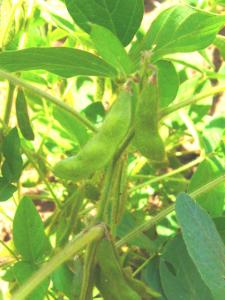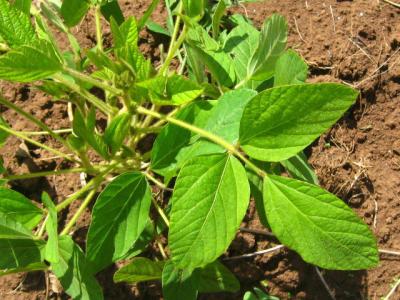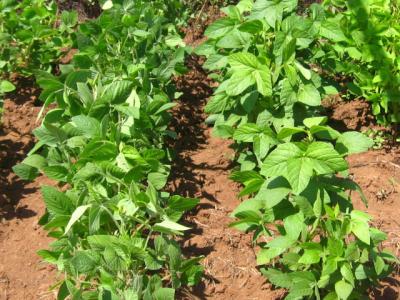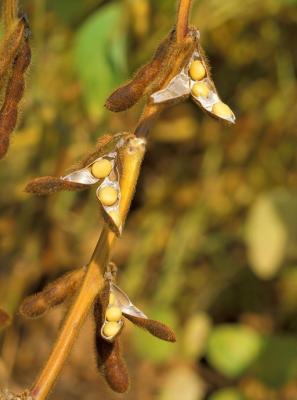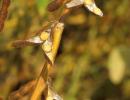
|
Soybean
Scientific name:
Glycine max
Order/Family:
Fabales: Fabaceae
Pests and Diseases:
Anthracnose
Aphids
Bacterial pustule
Bean flies
Bean yellow mosaic virus
Bugs
Cowpea seed beetle
Downy mildew
Leaf-feeding caterpillars
Leafmining caterpillars
Pod and stem blight
Pod borers
Purple seed stain
Root-knot nematodes
Sedges
Soybean bacterial blight
Soybean mosaic potyvirus
Soybean rust
Storage pests
White mould
Wildfire disease
Couch grass, Leafhoppers
|
Damping-off diseases and Anthracnose (Colletotrichum truncatum and Glomerella glycines)
They are caused by an array of fungi including Colletotrichum truncatum and Glomerella glycines (cause of anthracnose). The diseases cause rotting of seeds before emergence from the soil or death of seedlings after emergence.
The two species of fungi produce similar symptoms on the petioles, stems and pods particularly when plants are nearing maturity. Diseased areas have dark sunken lesions. Under moist weather the lesions become covered with a pink spore mass. The disease is seed-borne. When infected soybean seeds are planted, many of the seeds rot in the soil. Those that emerge from the soil often have brown, sunken cankers on the cotyledons (seedling leaves). The fungi may grow from them into the young stems. The damping-off seedling losses are probably more serious phases of soybean anthracnose than symptoms on older plants. The disease is favoured by cool wet weather.
- Use certified disease-free seeds.
- Plant resistant varieties, if available.
- Practise crop rotation with non-legumes.
- Practise proper water management.
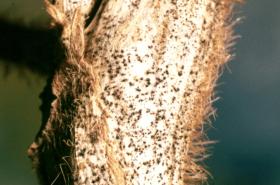
© Clemson University - USDA Cooperative Extension Slide Series, Bugwood.org

Anthracnos…

Brown blot…
The cotton aphid (Aphis gossypii)
It is a major pest of soybeans. Adults range from just under 1 to 1.5 mm in body length. Aphids are found in clusters (colonies) on stems, young shoots and pods and underside of leaves. They transmit the Bean Yellow Mosaic Virus on soybeans.
- Monitor regularly build-up of aphid population and natural enemies.
- When necessary use neem seed or leaf extracts for control. For further information on neem click here..
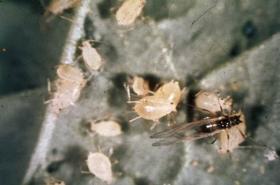
© Mississippi State University Archive, Mississippi State University, Bugwood.org
Bacterial postule (Xanthomonas axonopodis pv. glycines)
The symptoms are much like those of bacterial blight. At first they appear as small, yellow-green spots with reddish-brown centres, more conspicuous on the upper surface of the leaf. A small, raised pustule usually develops at the centre of the lesion, especially on the lower leaf surface. This is the stage at which the disease is most readily distinguished from bacterial blight. The pustule and the absence of water soaking serve to distinguish bacterial pustule from bacterial blight. The latter shows water soaking at the centre or the margin of the dead area in the early stages of infection. In bacterial pustule, small infections may run together and cause large, irregular brown areas surrounded by a yellow margin. Parts of the brown dead areas may crack, giving the leaf a ragged appearance. The bacteria causing bacterial pustule over-season in diseased leaves and are seed-borne. Some strains infect common bean and cowpea.
- Disease management is the same as in the case for bacterial blight: Practise proper field sanitation
- Use certified disease-free seeds
- Plant resistant varieties, if available
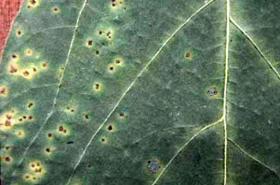
© Ved Prakash Gupta, Reproduced from the Crop Protection Compendium, 2006 Edition. © CAB International, Wallingford, UK, 2006.
Beanflies (Ophiomyia centrosematis and O. phaseoli)
Bean flies are (about 2mm long) flies, shiny black-bluish in colour. Female flies lay eggs on young leaves, piercing the leaves and sucking the exuding sap resulting in yellow blotches on the leaves, which are the first signs of bean fly attack and are useful for early detection of this pest. Maggots mine their way from the leaves down to the base of the stem, where they complete their development. Maggot feeding destroys the tissue causing the steam to swell and split and reducing formation of lateral roots.
Young seedlings and plants under stress wilt and die when attacked by bean flies. Older or vigorous plants may tolerate bean fly attack, but their leaves turn yellow, their growth is stunted and their yield reduced. Damage is more severe in plants growing under poor conditions such as infertile soils and drought. Under good conditions, soybean, however, can compensate for minor stand reductions; thus, small gaps dispersed in a field normally are filled by adjacent plants and no yield reductions are detected.
- Plant early in the season. Bean fly numbers tend to be low during the early stages of the growing season and increase with time.
- Provide favourable growing conditions to improve plant vigour and to enhance tolerance to bean fly attack.
- Avoid planting soybeans near cowpea, beans and other leguminous crops, that may be the source of bean flies.
- Remove and destroy crop residues and all plant parts with symptoms of damage by bean flies.
- Monitor the field shortly after emergence.
- Ridge the crop 2-3 weeks after germination. This helps to cover the adventitious roots, which are produced by plants damaged by bean flies. The soil support prevents lodging and improves the survival of the damaged plants.
- If necessary, spray neem extracts. Frequent foliar applications of neem extract give satisfactory control of bean flies.

© A.M. Varela, icipe

Bean fly

Bean fly
Bean yellow mosaic virus (BYMV)
Leaves of infected plants are not distorted as in SMV. The younger leaves show a yellow mottling scattered in random areas over the leaflets or sometimes an indefinite yellow band along major veins. Rusty necrotic spots develop in the yellowed areas as the leaves mature. Infected plants are not noticeably stunted. The disease is transmitted by aphids and infected seeds.
- Use certified disease-free seeds.
- Control aphids. For more information on aphid control click here.
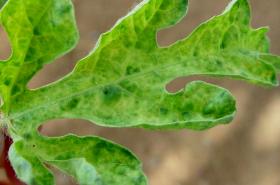
© A. M. Varela, icipe
Bugs
Sucking bugs are major soybean pests. They feed on pods and soft growing plant parts. While feeding they inject toxins into pods/seeds causing necrosis.
The most important are stink bugs (e.g. Nezara viridula, and Piezodorus hybneri), Riptortus bugs (Riptortus dentipes), Mirperus jaculus, giant coreid bugs (Anoplocnemis curvipes), and spiny brown bugs (Clavigralla spp.).
Extensive stink bugs feeding may result in pod abortion and the destruction of seeds. Severe pod abortion may induce such plants to remain in the vegetative stage, causing foliar retention, which poses problems at harvest. Thegreen stink bug (Nezara viridula) also injects a fungus (Nematospora coryli) into the developing seeds, which is the casual agent of the yeast spot disease. A single stink bug puncture may result in the loss of seed germination. Direct pod and seed injury may result in yield loss and decrease in seed quality due to microorganisms, even if plants compensate for considerable injury that occurs during early pod-set. Damage at the end of the seed- development will result in yield loss.
Sucking bugs are difficult to control since they are very mobile and can infest the crop from neighbouring crops.
- Sucking bugs are attacked by parasitic wasps and assassin bugs. In Ghana, a threshold of 2-3 bugs/metre row is suggested.
- Control strategies should be related to the stage of pod development. It has been shown that early pod fill is the most sensitive stage to attack by green stink bugs (N. viridula), and the only one in which yield, seed weight and oil content was significantly reduced. Bugs should be controlled before this stage is reached, i.e. towards the end of pod elongation. Once pod fill is completed, soybeans are not at risk and control is not warranted unless planting seed or edible seed is being grown (CABI, 2005).
- Research in Indonesia has shown that Sesbania rostrata is an effective trap crop, for managing stink bugs and Riptortus bugs on soybeans (Naito, 1981, 1996). Sesbania rostrata is taller than soybean, and since it takes longer to mature, it can also attract stink bugs over a longer period. In addition to attracting adults of N. viridula, it helps to reduce their numbers, since it is not a suitable food plant for nymphal development. Sesbania is usually planted on two opposite sides of a soybean field.
- Spraying with aromatic plants (e.g. gums, lantana, khaki weed,etc.) has been suggested to repel bugs (Elwell and Mass, 1995).
- Neem-based pesticides reportedly reduce feeding by green shield bugs.
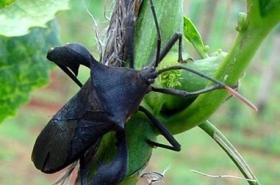
© A.M.Varela, icipe

Adult tip …

Stink bug

Spiny brow…

Riptortus …
Cowpea seed beetle
Adults are 2.0 - 3.5 mm long. They are also known as the cowpea seed beetles and are the principal storage pest of cowpea. These bruchids may infest up to 100% of the stored seeds within 3 to 6 months under ordinary storage conditions. A positive relationship between pod damage by field pest (pod sucking bugs and pod borers) and bruchid infestation in storage was found in Uganda. Controlling pests infesting pods of cowpeas in the field significantly reduce bruchid carryover in storage (IPM CRSP).
- Use neem extracts.
- Dry seeds for storage to a moisture level below 13%.
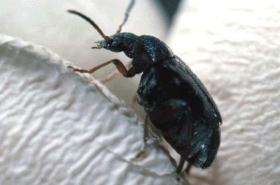
© Peter Credland. Reproduced from the Crop Protection Compendium, 2006 Edition.

Cowpea see…

Pupa of th…

Cowpea see…
Soybean downy mildew (Peronospora manshurica)
Early stages of the disease are characterised by indefinite yellowish-green areas on the upper surface of the leaves. As the disease progresses, those infected areas become greyish brown or dark brown and have yellowish-green margins. Severely infected leaves fall off prematurely. A greyish mould-like growth develops on the under surface of the spots when weather is wet and temperatures are cool. The disease also attacks the pods and infects the seeds. The disease is favoured by cool temperatures and wet conditions.
- Plant certified disease-free seeds.
- Use resistant varieties, if available.
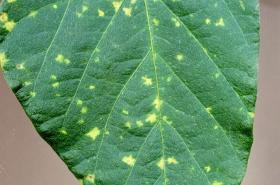
© Clemson University - USDA Cooperative Extension Slide Series, www.insectimages.org
Leaf-feeding caterpillars
Leaf-feeding caterpillars such as the cotton leafworm (Spodoptera littoralis), the beet armyworm (S. exigua) and thetomato looper (Chrysodeixis chalcites) are generally of minor economic importance, but serious outbreaks occasionally occur. In particular, S. littoralis often causes extensive damage to soybeans.
The bean webworm(Lamprosema indicata) feeds on leaves, which are spooned together, causing characteristic windowing as the upper epidermis of leaves remain untouched. This caterpillar may cause considerable damage in soybeans. Natural enemies are important to keep populations at low level.
- Conserve natural enemies. Caterpillars have a wide range of natural enemies (parasitic wasps, predators and pathogens) that are important in their natural control.
- Monitor the crop regularly.
- Hand pick eggs and caterpillars.
- Use botanicals (e. g. neem extracts) and biopesticides (e.g. Bt).
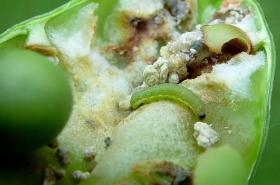
© A.M. Varela, icipe
Leafmining caterpillars
The groundnut leafminer (Aproaerema modicella) adult is a small greyish moth, with a full wing span of up to 18 mm. Eggs are laid singly on the underside of the leaves of groundnut, soybean and other leguminous plants. Caterpillars are 6 mm long at the time of pupation, and rarely exceed 8 mm in length. Young caterpillars mine the leaves; later as caterpillars get older they exit the mine to web together several leaflets.
Damaged leaves become brownish, rolled and desiccated, which results in early defoliation and affects the growth and yield of the plants.
This leafmining caterpillar is a pest of groundnut and soybean in South and Southeast Asia and has recently invaded Africa. It has become a major pest of groundnuts in several African countries and has also been reported causing damage to soybeans in Uganda. Some farmers have reported a 30% yield loss.
- Plant during the first short rains when normally the miner population is low.
- Avoid drought stress by irrigating or sowing so as to avoid periods when drought is likely. Plants that are drought stressed are much more susceptible to leafminer attack than irrigated plants.
- Monitor plants regularly, particularly when intercropped with or planted near groundnuts. In India, soybean plants have been recommended as trap crops to divert these leafminers from groundnuts.
- Treat with neem products as soon as infestation is detected. Early applications of neem products have been effective in India and Uganda.
Pod and stem blight (Diaporthe phaseolorum pv. sojae)
It kills the plants in the later stages of crop development. Stems, petioles, pods, seed and less frequently leaf blades may be infected. It can be easily identified by the numerous, small, black fungal fruiting bodies (pycnidia) that appear on the stems and pods of infected plants. On the pods, the pycnidia are scattered while on the stems they are usually arranged in rows. The disease is favoured by wet weather. The disease is seed-borne and can over-season on diseased stems in the field.
- Use certified disease-free seeds.
- Use resistant varieties, if available.
- Practise sanitation.
- Practise crop rotation with non-legumes.
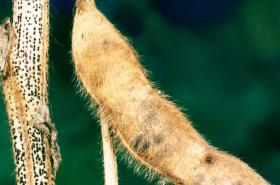
© Clemson University - USDA Cooperative Extension Slide Series, www.insectimages.org
Pod borers (Maruca vitrata, Etiella zinckenella, Helicoverpa armigera)
The legume pod borer (Maruca vitrata), the lima bean pod borer (Etiella zinckenella) and the African bollworm (Helicoverpa armigera) are major pests of soybeans. The adults are small moths. They are nocturnal and seldom seen in the field at daytime. Caterpillars of these moths feed on the floral parts and pods of legume plants, rendering them unmarketable. They scrape or bore through pod walls into the developing seeds.
For more information on African bollworm click here.
- Monitor the crop regularly.
- Spray with Bt o neem extracts or other plant extracts. It is very important to apply them before the young caterpillars enter into the pods. Once the caterpillars have entered the pods they are difficult to control and by then they have caused damage. Since the period between hatching to entering the pods is very short it is very important to monitor the crop frequently.
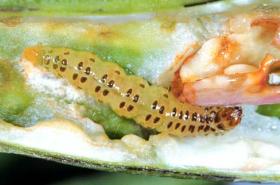
© Courtesy EcoPort (http://www.ecoport.org): P. Ooi

Legume pod…

Lima bean …

African bo…
Purple seed stain (Cercospora kikuchii)
Symptoms of purple stain are most evident on the seeds, but the fungus also attacks leaves, stems and pods. On the seeds, discolouration varies from pink or light purple to dark purple and ranges from a small spot to the entire seed coat. Cracks often occur on the discoloured areas giving the seed coat a rough, dull appearance. When infected seeds are planted, the fungus grows from the seed coats into the cotyledons (seedling leaves) and into the hypocotyls (seedling stem). The fungus produces spores abundantly on infected seedlings and these spores serve as source of infection to leaves, stems and pods. The spores are spread by wind and rain splash.
- Use certified disease-free seeds.
- Plant resistant varieties, if available.
- Avoid overhead irrigation.
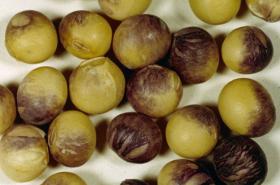
© Clemson University - USDA Cooperative Extension Slide Series, www.insectimages.org
Root-knot nematodes (Meloidogyne spp.)
Field symptoms are typically of stunted, poorly growing plants with yellowing leaves. They may cause also wilting and death of plants particularly in hot weather. Roots of affected plants are distorted, swollen and show characteristic knots or galls.
- Plant resistant varieties, where available.
- Rotate for at least 3 to 4 years with cereals.
- Use bio-products (e.g. neem extracts). Some are commercially available for nematode control.
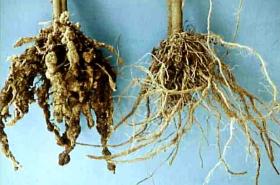
© A. M. Varela, icipe
Soybean bacterial blight (Pseudomonas savastonoi pv. glycinea)
Blight lesions are most conspicuous on leaves but also occur on stems, petioles, and pods. Small, angular, translucent, water-soaked, yellow to light brown spots appear on leaves. The centres soon dry out, turn reddish brown to black, and are surrounded by a water-soaked margin bordered by a yellowish green halo. Young leaves are most susceptible. Infected young leaves are distorted, stunted, and chlorotic. The angular lesions enlarge in cool, rainy weather and merge to produce large, irregular dead areas. P. savastonoi pv. glycinea over seasons in surface crop residue and in seeds. Seeds can be infected through the pods during the growing season, or they may be invaded during harvesting. Primary infections on cotyledons often result in secondary lesions on seedlings. The bacterium is spread during windy rainstorms and during cultivation while the foliage is wet. It is seed-borne.
- Use certified disease-free seeds.
- Plant resistant varieties, if available.
- Practise proper field sanitation.
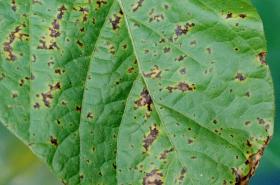
© Clemson University - USDA Cooperative Extension Slide Series, Bugwood.org
Soybean mosaic potyvirus (SMV)
Symptoms vary with host, virus strain, plant age at infection, and environment. Most infected cultivars are slightly stunted with fewer pods that are sometimes dwarfed and flattened, without hairs, and without seeds. Trifolilate leaves have a mosaic of light and dark green areas that may later become raised or blistered, particularly along the main veins. Primary leaves of some cultivars may show necrotic local lesions, which merge, into veinal necrosis followed by yellowing and leaf abscission.
Seeds from infected plants may be mottled brown or black, depending on hilum colour. Seeds may be smaller and germination reduced as compared to seed from non-infected plants. Mottling does not indicate that the virus is present in seeds as not all mottled seeds contain virus and not all seeds from virus-infected plants are mottled. SMV is sap and graft-transmissible. At least 32 aphid species, belonging to 15 different genera, transmit the SMV in a non-persistent manner. Virus isolates may show some vector specificity. Infected plants resulting from transmission through seed play an important role in SMV epidemiology. Such plants are sources for primary inoculum of SMV. In most cultivars, seed transmission is less than 5%, but no transmission occurs in some cultivars while others can have levels as high as 75%.
- Use certified disease-free seeds.
- Practise aphid control to reduce the spread of virus.
- Plant resistant cultivars, if available.
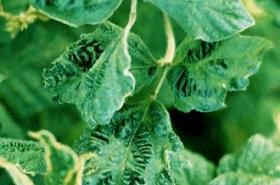
© L.Bos. Reproduced from the Crop Protection Compendium, 2006 Edition. © CAB International, Wallingford, UK, 2006.
Soybean rust (Phakopsora pachyrhizi)
The most common symptoms are grey green, tan to dark brown or reddish brown lesions particularly on the undersides of the leaflets. These lesions are called uredia and they contain spores of the fungus. The spores from uredia are called urediniospores. Lesions tend to be angular, are restricted by leaf veins, and reach 2-5 mm in diameter. Lesions may also appear on petioles, pods, and stems. With time uredia turn black and at this stage they are called telia and the spores they contain are called teliaspores.
Lesions are frequently associated with leaf chlorosis, and high lesion densities result in premature defoliation and early maturity. During the early stages of development before the onset of sporulation, rust lesions may be confused with bacterial pustules (see bacterial pustule/bean blight). However, the symptoms of the two diseases can be differentiated by the presence of multiple uredia in the rust lesion and by the irregular cracks that usually appear in host tissue with a bacterial pustule lesion. Rust epidemics are most severe during long periods of leaf wetness when the mean daily temperature is less than 28°C. Urediniospores are the primary means of disease spread. Soybean is susceptible at any stage of development, but symptoms usually appear from the middle to late in the season because a prolonged wet, cool period is required for infection and sporulation. Spread of urediniospores is by windblown rain. The pathogen is not seed-borne in soybean. Rust can reduce yield by as much as 90%.
- Plant resistant varieties, if available.

© Reid Frederick, USDA Agricultural Research Service, www.insectimages.org
Storage pests (Sitophilus oryzae, Rhyzopertha dominica)
Larva of storage moths (Ephestia cautella, Corcyra cephalonica) and bruchid beetles (Callosobruchus spp.) cause extensive damage to soybean grains.
The forewings of the adult moth E. cautella are greyish-brown with an indistinct pattern. The wing span is 1-2 cm.
- Rice husk ash was found to be effective against bruchid beetles (Callosobruchus analis) in Indonesia. Fresh, dry ash should be used, at a rate of around 1% of the seed weight. The rice husk ash should be spread by hand over well-dried soybean seeds stored in a can with a capacity of 6 - 18 litres. The ash should be gently mixed with the seed by hand, and the lid placed tightly on the can. The can should be kept in a cool, dark place (Naito, 1981).
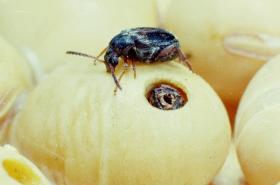
© Clemson University - USDA Cooperative Extension Slide Series, Bugwood.org

Bean bruch…

Cowpea see…

Storage mo…
White mould (Sclerotinia sclerotiorum)
It is characterised by a rot at the base of the plant stem. The rot is covered by a cottony, fungal (mycelial) growth on which black irregularly shaped fungal bodies (sclerotia) are produced. Size of sclerotia varies from 2 to 22 mm in diameter. The disease infects the stem and pods. Large, black, round to irregularly-shaped sclerotia of varying size form on stems, which are partially covered with dense white mycelium. Sclerotia are also formed in the stem pith and are conspicuous when the stem is opened. Seeds may become infected within diseased pods. If infected early, seeds are flattened and shrivelled and sometimes replaced by black sclerotia. Attacked plants die prematurely, sometimes before seeds have formed. Infection occurs at flowering. Moderate air temperatures and frequent rains just prior to flowering to the pod development stage of growth favour the disease.
- Use certified disease-free seeds.
- Plant resistant varieties, if available. Early maturing cultivars tend to escape infection because of their usually short stature and early flowering. In contrast, late maturity cultivars are believed to have more disease because of lush vegetative growth and later flowering.
- Avoid planting soybean directly after common bean, sunflower or rape.
- Avoid planting highly susceptible cultivars if row spacing is less than 76 cm in fields with a history of the disease.
- Avoid excessive irrigation until flowering has ceased.
- Use good weed control practices.
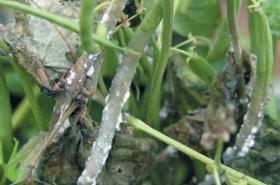
© David B. Langston, University of Georgia, Bugwood.org
Wildfire disease of soybeans (Pseudomonas syringae pv. glycinea)
Symptoms consist of light-brown necrotic spots of variable size, surrounded by broad yellow halos on the leaves. In damp weather the spots enlarge forming large dead areas on the leaf. Wildfire disease is commonly associated with bacterial blight and bacterial pustule infections. The bacteria causing wildfire are seed-borne and also are carried over in crop debris.
- Disease management is the same as in the case for bacterial blight and bacterial pustule.
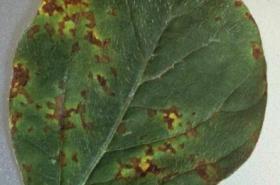
© ENSA-Montpellier Archive, Ecole nationale supérieure agronomique de Montpellier, Bugwood.org
| General Information and Agronomic Aspects | Information on Diseases | |||
| Information on Pests | Information Source Links |
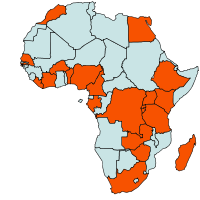 |
| Geographical Distribution of Soybean in Africa |
Soybean is also one of the crops where many varieties are now genetically modified - especially in the American market.
In sub-Saharan Africa, soybean is mostly grown by small-scale farmers either as a sole crop or mixed with sorghum, maize or cassava.
Nutritive Value per 100 g of edible Portion
| Raw or Cooked Soybean | Food Energy (Calories / %Daily Value*) |
Carbohydrates (g / %DV) |
Fat (g / %DV) |
Protein (g / %DV) |
Calcium (g / %DV) |
Phosphorus (mg / %DV) |
Iron (mg / %DV) |
Potassium (mg / %DV) |
Vitamin A (I.U) |
Vitamin C (I.U) |
Vitamin B 6 (I.U) |
Vitamin B 12 (I.U) |
Thiamine (mg / %DV) |
Riboflavin (mg / %DV) |
Ash (g / %DV) |
| Soybean Oil | 884 / 44% | 0.0 / 0% | 100.0 / 154% | 0.0 / 0% | 0.0 / 0% | 0.0 / 0% | 0.0 / 0% | 0.1 / 0% | 0.0 IU/ 0% | 0.0 / 0% | 0.0 / 0% | 0.0 / 0% | 0.0 / 0% | 0.0 / 0% | 0.0 |
| Green Soybeans cooked | 141 / 7% | 11.1 / 4% | 6.4 / 10% | 12.3 / 25% | 145 / 14% | 158 / 16% | 2.5 / 14% | 539 / 15% | 156 IU / 3% | 17.0 / 28% | 0.1 / 3% | 0.0 / 0% | 0.3 / 17% | 0.2 / 9% | 1.6 |
| Green Soybeans raw | 147 / 7% | 11.1 / 4% | 6.8 / 10% | 13.0 / 26% | 197.0 / 20% | 194.0 / 19% | 3.6 / 20% | 620.0 / 18% | 180 IU / 4% | 29.0 / 48% | 0.1 / 3% | 0.0 / 0% | 0.4 / 29% | 0.2 / 10% | 1.7 |
| Soybeans mature cooked | 173.0 / 9% | 9.9 / 3% | 9.0 / 14% | 16.6 / 33% | 102.0 / 10% | 245 / 24% | 5.1 / 29% | 515.0 / 15% | 9.0 IU / 0% | 1.7 / 3% | 0.2 / 12% | 0.0 / 0% | 0.2 / 10% | 0.3 / 17% | 1.9 |
| Soybeans mature raw | 446 / 22% | 30.2 / 10% | 19.9 / 31% | 36.5 / 73% | 277 / 28% | 704 / 70% | 15.7 / 87% | 1797 / 51% | 22.0 IU / 0% | 6.0 / 10% | 0.4 / 19% | 0.0 / 0% | 0.9 / 58% | 0.9 / 51% | 4.9 |
| Soybeans mature roasted | 471 / 24%2% | 33.5 / 11% | 25.4 / 39% | 35.2 / 70% | 138.0 / 14% | 363.0 / 36% | 3.9 / 22% | 1470.0 / 42% | 0.0 / 0% | 2.2 / 4% | 0.2 / 10% | 0.0 / 0% | 0.1 / 7% | 0.1 / 9% | 3.9 |
| Soybeans sprouted cooked | 81.0 / 4% | 6.5 / 2% | 4.5 / 7% | 8.5 / 17% | 59.0 / 6% | 135.0 /14% | 1.3 / 7% | 355 / 10% | 40 IU / 1% | 8.3 / 14% | 0.1 / 5% | 0.0 / 0% | 0.2 / 14% | 0.1 / 3% | 1.1 |
| Soybeans sprouted raw | 122 / 6% | 9.6 / 3% | 6.7 / 10% | 13.1 / 26% | 67.0 / 7% | 164.0 / 16% | 2.1 / 12% | 484 / 14% | 11.0 IU / 0% | 15.3 / 26% | 0.2 / 9% | 0.0 / 0% | 0.3 / 23% | 0.1 / 7% | 1.6 |
Temperatures below 21°C and above 32°C can reduce floral initiation and pod set. Extreme temperatures above 40°C are detrimental for seed production.
If water is available, soybeans can be grown throughout the year in the tropics and subtropics. Soybean requires 400 to 500 mm in a season for a good crop. High moisture requirement is critical at the time of germination, flowering and pod forming stage. However, dry weather is necessary for ripening. Soybeans can tolerate brief waterlogging but weathering of seed is a serious problem in the rainy season.
Soybeans are sensitive to low pH. In acid soils, liming is essential to raise the pH to 6.0 or 6.5 and to obtain optimum yield. Manganese (Mn), iron (Fe) and aluminum (AI) toxicity is common with low pH, and deficiency in Mn and Fe with high pH. Cultivars tolerant to iron deficiency are available.
Examples of different soybean varieties grown in Kenya and their parameters:
| Characteristics/ varieties | "Hill" | "Perry-41" | "Black Hawk" | "Red-Tanner" | "Sable" | "Gazelle" | "Duiker" | "EAI 3600" | "SCS I2 | "Nyala" |
| Production altitude (masl) | 0-2200 | 0-2200 | 0-2200 | 0-2200 | 0-2200 | 0-2200 | 0-2200 | 0-2200 | 0-2200 | 0-2200 |
| Days to flowering | 83 | 61 | 89 | 65 | 59 | 56 | 90 | 68 | 68 | 59 |
| Days to physiological maturity | 151 | 131 | 120 | 138 | 132 | 133 | 127 | 123 | 132 | 128 |
| Plant height (cm) | 48 | 48 | 70 | 70 | 63 | 51 | 54 | 57 | 58 | 46 |
| Seed yield kg/ha | 1800 | 1800 | 1800 | 1800 | 1600 | 2600 | 1670 | 2500 | 2600 | 2500 |
| Oil content (%) | 20.7 | 18 | 18 | 18 | 17.9 | 22 | 16 | 17.8 | 19.8 | 17 |
| Protein content (%) | 33 | 35 | 35 | 35 | 35 | 35 | 34 | 35 | 34 | 33 |
|
|
|
| Description | Area in Kenya | Varieties |
| Warm temperature sites | Homa Bay | "Duicker", "EAI 3600" and "Nyala" |
| Moderate temperature sites | Bukura, Kakamega, Embu | "SCS I", "Duicker", "Nyala" and "Gazelle" |
| Cool temperature sites | Bahati, Baraton, Menengai | "Sable", "SCS I", "Nyala" and "Gazelle" |
| Marginal rainfall sites | Matayos, Gachoka, Makueni, Ol Rongai | "Gazelle", "EAI 3600", "Nyala" and "Sable" |
A recommended soybean variety in Tanzania:
- "Soya Uyole 1" (optimal production altitude: 1000-1800 m; grain yield per ha: 1500-3000 kg; resistant to lodging and shattering)
Examples of recommended soybean varieties in Uganda:
- "Maksoy 1N" (maturity: 95 days; yield per ha: 2000 kg; resistant to soybean rust, lodging and pod shattering; good for intercropping)
- "Namsoy 4M" (maturity: 100 days; yield per ha: 2000 kg; resistant to soybean rust, lodging and pod shattering; good for intercropping)
- "MNG 8.10" (yield per ha: 2500 kg; resistant to soybean rust)
Intercropping soybean with maize attracts parasitic wasps that control African bollworm (Helicoverpa armigera) and at the same time serves as weed cover. Soybeans should not be grown on the same site for more than two years to prevent a build-up of soil-borne diseases. Practise crop rotation of 3 to 4 years as a part of disease control. The plant grows best in a rotation after maize or small grains but should not follow edible beans, rape, or sunflowers because white mould disease can be carried over.
Soybeans can be harvested by hand or by combine harvesters (this only at full maturity or after windrowing - cutting plants and leaving them in rows for wind and sun to dry properly). Once threshed, dry the soybeans to below 12 % moisture content before storing. Keep in a clean store and prevent weevil attack by any of the means described under storage pests. Seeds meant for seed should not be stored for longer than 1 year due to rapid loss of germination capability. For more information on storage pests click here
|
The cotton aphid (Aphis gossypii) It is a major pest of soybeans. Adults range from just under 1 to 1.5 mm in body length. Aphids are found in clusters (colonies) on stems, young shoots and pods and underside of leaves. They transmit the Bean Yellow Mosaic Virus on soybeans. | 
Cotton aphid
Cotton aphid (Aphis gossypii) is a small aphid. Adults range from just under 1-1.5 mm in body length. © Mississippi State University Archive, Mississippi State University, Bugwood.org |
|
What to do:
|
|
Pod borers (Maruca vitrata, Etiella zinckenella, Helicoverpa armigera) The legume pod borer (Maruca vitrata), the lima bean pod borer (Etiella zinckenella) and the African bollworm (Helicoverpa armigera) are major pests of soybeans. The adults are small moths. They are nocturnal and seldom seen in the field at daytime. Caterpillars of these moths feed on the floral parts and pods of legume plants, rendering them unmarketable. They scrape or bore through pod walls into the developing seeds.
| 
Legume pod borer
Legume pod borer (Maruca vitrata) reach a length of 18 mm © Courtesy EcoPort (http://www.ecoport.org): P. Ooi |
|
What to do:
|
Other serious diseases are: Bacterial pustule (Xanthomonas axonopodis pv. glycines) /Soybean bacterial blight (Pseudomonas savastonoi pv. glycinea), Soybean downy mildew (Peronospora manshurica), Anthracnose (Colletotrichum truncatum and Glomerella glycines), Purple seed stain (Cercospora kikuchii), Pod and stem blight (Diaporthe phaseolorum var. sojae), Soybean mosaic potyvirus, Bean yellow mosaic virus and various seedling diseases.
|
Bean yellow mosaic virus (BYMV) Leaves of infected plants are not distorted as in SMV. The younger leaves show a yellow mottling scattered in random areas over the leaflets or sometimes an indefinite yellow band along major veins. Rusty necrotic spots develop in the yellowed areas as the leaves mature. Infected plants are not noticeably stunted. The disease is transmitted by aphids and infected seeds. | 
Mosaic virus
Mosaic virus on watermelon © A. M. Varela, icipe |
|
What to do:
|
- AIC (2002). Field Crops Technical Handbook. Nairobi
- Blay, E., Cudjoe, A. R., Braun, M. (eds) (2000). Handbook of crop protection recommendations in Ghana: An IPM approach Vol:1 Cereals and pulses. Plant Protection & Regulatory Services Directorate and Integrated Crop Protection Project (ICP) German Development Co-operation (GTZ/PPRSD.
- Bohlen, E. (1973). Crop pests in Tanzania and their control. Federal Agency for Economic Cooperation (bfe). Verlag Paul Parey. ISBN: 3-489-64826-9.
- Brier H.B. and Rogers, D.J. (1991). Susceptibility of soybeans to damage by Nezara viridula (L.) (Hemiptera: Pentatomidae) and Riptortus serripes (F.) (Hemiptera: Alydidae) during three stages of pod development. Journal of the Australian Entomological Society, 30(2):123-128.
- CABI. (2005). Crop Protection Compendium, 2005 Edition. © CAB International Publishing. Wallingford, UK. www.cabi.org
- Major Soybean Pests of the World. www.nsrl.uiuc.edu
- Naito, A. (1981). Low-Cost Technology for Controlling soybean insect pests in Indonesia. Association for International Cooperation of Agriculture and Forestry (AICAF). www.agnet.org. African Entomology. 102: 97-99. IITA. 1981.
- Naito, A. (1996). Insect pest control through use of trap crops. Agrochemicals Japan, 68, 9-11.
- Nutrition Data www.nutritiondata.com.
- Participatory evaluation of the distribution, status and management of the groundnut leafminers in the Teso and Lango farming systems. Final technical report. NARO/DFIFD COARD Project. October 2004. By George Epieru Naro Saari.
- Paulraj, M.P. and S. Ignacimuthu. (2006). Integrated control of groundnut leaf miner. Entomology Research Institute Loyola College, Chennai. www.thehindu.com
- Suzuki N, Hokyo N, Kiritani K. (1991). Analysis of injury timing and compensatory reaction of soybean to feeding of the southern green stink bug and the bean bug. Applied Entomology and Zoology, 26(3):279-287.
- Todd J.W. (1989). Ecology and behavior of Nezara viridula Annual Review of Entomology, 34:273-292.
- University of Illinois National Soybean Research Centre: www.soydiseases.uiuc.edu

 Back
Back
